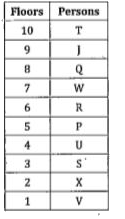There are ten persons J,P,Q,R,S,T,G,U,V and X living in a ten-floor building, such that ground floor is numbered as 1, just above the floor is numbered as 2 and so on the topmost floor is numbered as 10, but not necessary in the same order.
P lives on the 5th floor. Only three persons live between P and V. T lives immediate above J, who lives on an odd numbered floor. S lives on one of the floors below R. Number of persons lives between J and P is same as number of persons lives between T and R. There is only one floor in between U and X. W lives on an odd numbered floor. R does not live on top floor. S lives on an odd numbered floor above X but not on seventh floor. V lives below the floor on which P lives. U lives above the floor on which X lives. Q lives on an even numbered floor above P but not on top floor.
Three of the following four are alike in certain way based from a group, find the one which does not belong to that group ?
Q
X
U
W
The correct Answer is:D
Similar Questions
यदि A और B दो घटनाएँ इस तरह से हों कि P(A)=13,P(B)=14,P(A∩B)=15 तो P(A/B)=
View Solutionनिम्नलिखित कथनों पर विचार करें :
कथन I : यदि A और B प्रतिदर्श समष्टि S के संगत दो घटनाएँ ऐसा है कि P(A)=0.2 और P((B)=0⋅8 तो A⋃B एक सुनिश्चित घटना है |
कथन I : यदि A और B परस्पर अपवर्ती हों तो P(A)+P(B)=1 इन कथनो में :
View Solutionबिन्दु (0,-1,3) से तल 2x+y-2z+1=0 पर लम्ब की लम्बाई है
View Solutionयदि S कोई प्रतिदर्श समष्टि तथा E कोई घटना है तो घटना E की प्रायिकता P(E)=.....
View Solutionयदि A तथा B दो स्वतंत्र घटनाएँ हों, तो सिद्ध करें कि P(A∪B)=1−P(A')P.(B')
View Solutionविलयन समीकरण P = …………. T है.
View SolutionP and Q are the middle points of two chords (not diameters) AB and AC respectively of a circle with centre at a point O. The lines OP and OQ are produced to meet the circle respectively at the points R and S. T is any point on the major arc between the points R and S of the circle. If ∠BAC=32∘,∠RTS = ?
View SolutionP∗q=p2−q2
p%q=p2−q2
p$q=p2+q2
p∘q=pq+p+q
pΔq = Remainder of pq
p©q = greatest integer less than or equal to pq.
If p=11andq=7 , then the value of (p∗q)∘(p$q) is:
View Solution
